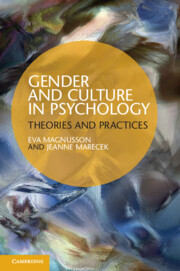Book contents
- Frontmatter
- Contents
- Preface
- 1 Gender and culture in psychology: a prologue
- 2 Categories and social categorization
- 3 Laying the foundation
- 4 Theories of gender in psychology: an overview
- 5 A turn to interpretation
- 6 Doing interpretative psychological research
- 7 Discursive approaches to studying gender and culture
- 8 Gender and culture in children's identity development
- 9 Identity and inequality in heterosexual couples
- 10 Coercion, violence, and consent in heterosexual encounters
- 11 Women's eating problems and the cultural meanings of body size
- 12 Psychological suffering in social and cultural context
- 13 Feminism and gender in psychotherapy
- 14 Comparing women and men: a retrospective on sex-difference research
- 15 Psychology's place in society, and society's place in psychology
- References
- Index
10 - Coercion, violence, and consent in heterosexual encounters
Published online by Cambridge University Press: 05 June 2012
- Frontmatter
- Contents
- Preface
- 1 Gender and culture in psychology: a prologue
- 2 Categories and social categorization
- 3 Laying the foundation
- 4 Theories of gender in psychology: an overview
- 5 A turn to interpretation
- 6 Doing interpretative psychological research
- 7 Discursive approaches to studying gender and culture
- 8 Gender and culture in children's identity development
- 9 Identity and inequality in heterosexual couples
- 10 Coercion, violence, and consent in heterosexual encounters
- 11 Women's eating problems and the cultural meanings of body size
- 12 Psychological suffering in social and cultural context
- 13 Feminism and gender in psychotherapy
- 14 Comparing women and men: a retrospective on sex-difference research
- 15 Psychology's place in society, and society's place in psychology
- References
- Index
Summary
In the course of their lives, many women and girls face sexual coercion and physical or sexual violence. Across the world, such gender-linked violence has been a major focus of feminist movements, beginning in “speak-outs” and anti-rape demonstrations in the 1970s (Gavey, 2009). Until then, it was believed that rape and other forms of sexual assault were rare; rapists were assumed to be violent criminals attacking unknown female victims. Feminists have shown that both these surmises are wrong (Gavey, 2009). Sexual coercion and violence by men against women are not rare. The typical perpetrator of violence and sexual coercion is not a stranger, but someone known to the woman (Swedish National Council for Crime Prevention, 2002).
Feminist researchers view sexual violence as a broad continuum of acts, with rape as the extreme. Thinking in terms of a continuum of sexual violence opens the way to new conceptions of both sexual violence and heterosexual intimacy. For example, many of women's experiences that were previously seen simply as sex might be reconceived as sexual victimization. Furthermore, normative heterosexual practices – both normal male sexuality and normal female sexuality – need to be rethought and re-evaluated (Gavey, 1999). In this chapter we present the work of Nicola Gavey, one of the feminist researchers who have led the way toward such rethinking and reconceptualization. Gavey's way of thinking about and researching issues of heterosexual coercion and violence draws on discursive psychology and post-structuralist theory as well as feminist thought.
- Type
- Chapter
- Information
- Gender and Culture in PsychologyTheories and Practices, pp. 109 - 118Publisher: Cambridge University PressPrint publication year: 2012



